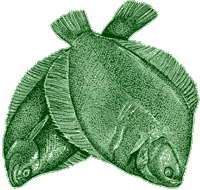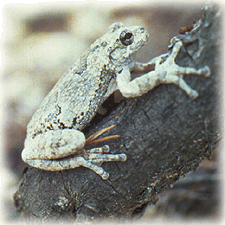| This lesson plan is reprinted with permission from the “Biology of the Hudson-Raritan Estuary” January 1998, Education Program, et.al. NJ Marine Sciences Consortium, Building 22, Fort Hancock, New Jersey 07732
Subject Areas
Science, Language Arts, Art
Duration
One or two class periods Optional: Activity Two as a Homework Assignment
Setting
Classroom
 Skills Skills
Inferring, examining, comparing, describing, classifying, interpreting
Charting the Course
The diversity of life that exists in the Delaware Estuary is an integral component of any investigation into the unique character of the region. While this activity is written specifically about marine organisms and fish, the concepts and applications could easily be modified and adapted for other groups of organisms: birds, mammals, insects, etc.
Vocabulary
Adaptation, benthic, morphology, anatomical, physiological, behavioral
Correlation to NJ Core Curriculum Content Standards
Science: 5.6 (4), 5.7 (1,4,6,7,8), 5.12 (1) |
Objectives
Students will
- Learn how an organism’s anatomy and morphology can reveal how it lives and functions.
- Describe specific adaptations of marine species, especially fish.
Materials
Library access (for Activity Two) or various field guides to marine animals
Paper, pencil
Several whole fish of different shapes from the Delaware Estuary, obtained either through seining or from a local fish market (the fish should be fresh and frozen immediately after being caught)
Suggestions include: fluke, flounder, skate or ray, an eel, a sea bass, a spot, and a tuna, mackerel or bonito*
* These can often be obtained for free if the intent as an educational project is explained.
Newspaper, paint (tempera) or ink, brushes, colored pencils or markers
Newsprint, cloth, or other medium to which paint can be applied (even T-shirts!)
Making Connections
The wildlife that inhabits the estuary is uniquely adapted to the environmental conditions that exist there. Often harsh, due to saltiness, and sporadic, due to constantly changing conditions, the species that live in the estuary contain numerous examples of adaptations that make them better suited to survival in this environment.
Examining the diversity of life that exists here is a means to engage students in critical thinking and applying scientific knowledge to animals that they know and that are familiar. Awareness and appreciation are the first steps toward an environmental ethic and sense of stewardship. These activities will introduce the aquatic wildlife of the region and provide a fun and exciting learning environment.
Background
Most organisms are adapted to a specific way of life. Adaptations may be behavioral, anatomical, or physiological. Many adaptations can be understood through observation and understanding how the animal lives. For example, we know that fish live in water and have ways to move through water to keep themselves afloat. We also know that sea stars love to eat bivalves, and they have developed a way to open tightly closed shells to eat the animal inside.
Several features of an organism can indicate how it lives. For example, we know by the shape, color and eyes of a flounder that it lives on the sea bed and swims like a flying bird. Because its top is brown, it blends in with the ocean (or bay) floor. Since it lives on and near the bottom, both eyes are on the same side of its head. Fish that are flat or depressiform like a skate or a flounder flap their fins up and down to swim through the water in the same way that a bird flaps its wings. Meanwhile, fish that are long and skinny like an eel slither through the water like a snake. Fish that have an oval or a fusiform cross-section like some tunas are fast swimmers and usually live in open water. An oblong or compressiform shape like that of menhaden (moss bunker) means the fish is built for quick bursts of speed over short distances. The shape of a fish’s tail indicates how the fish moves as well. A rounded tail or truncate tail like that of a killifish or minnow is good for maneuverability and short bursts of speed. This kind of tail is commonly found on fish in coastal embayments. A forked tail like that of a sardine is good for maneuverability and speed over longer distances. Lunate tails like those found on a swordfish are not good for maneuvering but allow for speed over long distances and are usually seen on fish in the open ocean.
The following is a series of activities that involves observing and discussing the morphology and anatomy of various organisms, focusing on how this relates to the animal’s lifestyle and behavior.
Procedure
Warm Up
Introduce the concept of adaptation. Show photos of a variety of animals and have the class brainstorm the types of adaptations evident in the photos (i.e., the hooked bill of an osprey, the streamlined shape of a bluefish, the long legs of an egret, etc.). Discuss the importance of adaptations as providing organisms with specific physical qualities that allow them to survive in their habitats.
The Activities
Activity One
 Define and discuss three types of adaptations. Try to describe an example of an organism found within the Delaware Estuary or Down Jersey region. Define and discuss three types of adaptations. Try to describe an example of an organism found within the Delaware Estuary or Down Jersey region.
- Read the following sentences and decide whether the sentences describe an anatomical, physiological, or behavioral adaptation:
A. Sea gulls that live near people feed on garbage at garbage dumps.
B. An osprey has clawed feet coated with small spines or spicules so it can grasp slippery fish.
C. A clapper rail hides in marsh grasses for protection.
D. A pipefish turns from gray to muddy brown as it swims to the bottom of the estuary.
E. A mallard duck has webbed feet to help it swim.
F. Hermit crabs hide in their shells for protection.
G. The male egret grows a large yellow plume during mating season.
H. The razor clam has a muscular, hatchet-like foot that anchors it into the sand.
I. Squid emits a black ink to blind a predator that is pursuing it.
J. Marsh snails climb to the top of the salt marsh cordgrass during high tides to avoid drowning.
Definitions:
anatomical adaptation:
changes in the structure of an organism that make it more fit to the conditions of the environment.
behavioral adaptation:
changes involving action and response to stimulation that make an organism more fit to the conditions of its environment.
physiological adaptation:
physiological adaptations refer to the internal functioning mechanisms of an organism.
Activity Two
- Choose a benthic organism that lives in the Delaware Estuary. Go to the library or use field guides and research the lifestyle and behaviors of the organism chosen. Write a classified ad or a personal ad for which that organism would be suited.
- Have the students read their ads out loud and let the other students guess what organism it was written for. Once they guess correctly, the students explain what is it about their morphology or anatomy that makes them most suitable for the position or description included in the ad.
Example 1: Classified Ad
Looking for an experienced driller for clam mining operation. Must work neatly. (Oyster Drill — An oyster drill has a special organ called a radula which is like a tongue with teeth. This snail will drill perfectly round little holes in a clam shell to get at the meat inside.)
Example 2: Personal Ad
Feisty freckled male seeks a crabby lady with attitude. If you like surf and sand and a good fight, you’re the one for me. (Lady Crab — This pale grayish crab has clusters of purple specks all over it. It is usually found in shallow water with sandy habitats. It is an ill-tempered crab that needs to be handled with care.)
Activity Three
- Thaw fish specimens under cold water 1/2 hour before using them. Dry the fish well and place them on newspaper.
- Look at the different fish.
Have the students examine them and identify distinguishing characteristics and adaptations: mouth shape, fin size and shape and how they relate to movement, overall body shape, eyes, etc. If an aquarium is available, spend a few minutes watching fish move.
- Take a paint brush and brush a very thin layer of paint over a fish (the less paint used, the better the result.) Place a piece of paper or cloth (or the T-shirt) over the painted fish and gently press it down around the edges of the fish, taking care not to squash the fish. Lift the paper or cloth to reveal the fish print. Do not wash the fish between prints. Often a fresh coat of paint is not necessary before the next print.
- When the print has dried, label the different parts of the fish’s external anatomy on the print, write the name of the fish, and write the shape of the fish with a description of how the fish moves.
Assessment
Have students describe marine organisms’ adaptations and how they benefit the survival of these species. Give examples of different types of adaptations.
Extensions
Excerpts from Aquatic Project WILD, page 80
- Using some basic adaptations of fish, have students design their own fish. Students should describe the type of habitat that their fish is adapted to. Include descriptions of: how the fish eats, what it eats, how it reproduces, moves, etc. (See Aquatic WILD Activities — Fishy Who’s Who and Fashion a Fish)
- Make replicas of some fish in three dimensions. Hang them in the classroom as mobiles. Let the classroom become an aquatic habitat!
- Explore why some fish species or types occur widely, in various habitats, while others are more restricted or specialized. What special needs or abilities do they have?
- Find out how some fish got their names. Why is a sheepshead minnow a sheepshead minnow? A stickleback a stickleback? Investigating and researching the scientific names is also interesting to explore.
- There may be hatcheries, fish research stations, or other places doing work with fish and fish habitat near your school. If possible, arrange a tour of these facilities for the class.
- Are there any special fish habitat “hot spots” in the region? Places where fish are in danger because of human or natural actions?
- Conduct a “creel survey.” This involves conducting interviews of people whom you find fishing — for example, along streams, in lakes, at the bay, etc.
- Visit a fishing dock to see how they operate.
- Investigate current fish advisories, size limits, licensing requirements, etc. Contact the New Jersey Department of Environmental Protection Division of Fish, Game and Wildlife at (609) 748-2031 for more information.
Please download the PDF for the complete Lesson Plan.
| Resources
Biology of the Hudson-Raritan Estuary
January 1998, Education Program, et. al. NJ Marine Sciences Consortium, Building 22, Fort Hancock, NJ 07732
Project WILD Aquatic, Western Regional Environmental Education Council, 1987.
The Peterson Field Guide Series — A Field Guide to Atlantic Coast Fishes of North America
Robins, C.R., G.C. Ray and J. Douglass. 1986. Houghton Mifflin Company, Boston. 354 pp. |
|


 Skills
Skills Define and discuss three types of adaptations. Try to describe an example of an organism found within the Delaware Estuary or Down Jersey region.
Define and discuss three types of adaptations. Try to describe an example of an organism found within the Delaware Estuary or Down Jersey region.